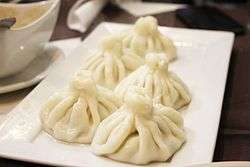Khinkali
Khinkali (Georgian: ხინკალი khink’ali ![]()
 | |
| Alternative names | xinkali, hinkali |
|---|---|
| Type | Dumpling |
| Place of origin | Georgia |
| Region or state | Mtskheta-Mtianeti |
| Serving temperature | hot |
| Main ingredients | Filling: spiced meat (beef, pork, or lamb), herbs, onions, and garlic. Cheese, potato, or mushroom fillings are alternatives to meat. |
Ingredients
The fillings of khinkali vary with the area. The original recipe, the so-called khevsuruli, consisted of only minced meat (lamb or beef and pork mixed), onions, chili pepper, salt, and cumin. However, the modern recipe used mostly especially in Georgian urban areas, the so-called kalakuri, uses herbs like parsley and cilantro (also called coriander). Mushrooms, potatoes, or cheese may be used in place of meat.
Etiquette
Khinkali is eaten plain or with ground black pepper. The meat filling is uncooked when khinkali is assembled, so when it is cooked, the juices of the meat are trapped inside the dumpling. To make khinkali juicier, usually warm water or broth is added to the minced meat. Khinkali is typically consumed first by sucking the juices while taking the first bite, similar to xiaolongbao, in order to prevent the dumpling from bursting. The top, where the pleats meet, is tough, and is not supposed to be eaten, but discarded to the plate so that those eating can count how many they have consumed. In Georgia, this top is called the kudi (Georgian: კუდი, "tail") or k'uch'i (Georgian: კუჭი, "stomach").
There is a widespread etiquette in Georgia to use only one's bare hands while consuming these dumplings. The using of utensils, like a fork, is considered incorrect or childish. This is because the tastiest part of the khinkali is its juice; using a fork will rupture the khinkali and the juice will be spilled.
Regions
The towns of Dusheti, Pasanauri and Mtskheta are particularly famous for their khinkali.
See also
References
External links
| Wikimedia Commons has media related to Khinkali. |